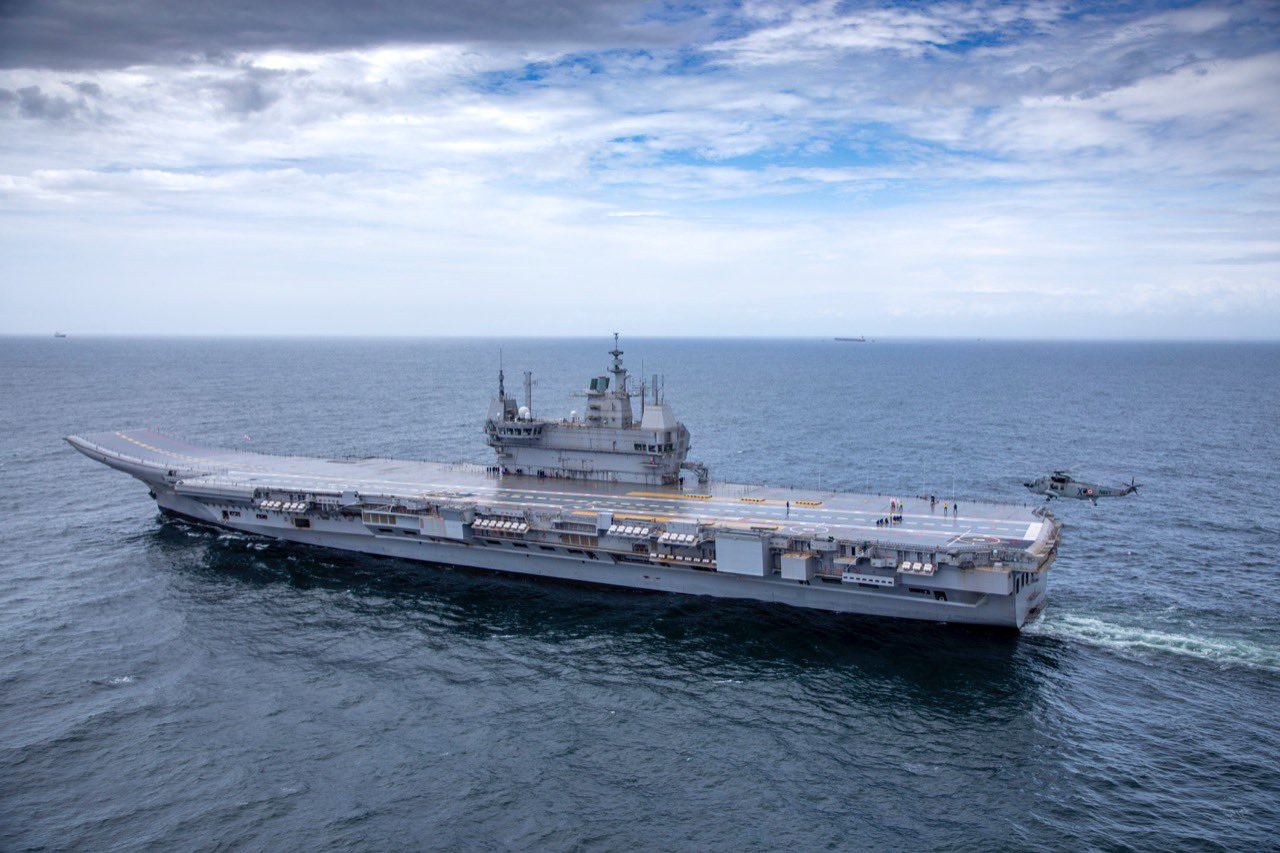
India’s first indigenous aircraft carrier IAC-1, or INS Vikrant is on the brink of getting commissioned having completed its first field trials. When it is eventually commissioned into the Indian Navy, India would once again have the luxurious comfort of two carriers, INS Vikramaditya and INS Vikrant. Although it has taken almost 10 years to fructify it still remains the most ambitious project undertaken by the Indian Navy after INS Arihant. Concurrently, the Indian Navy is also desperately seeking approval to initiate the IAC-2 project towards a larger aircraft carrier in due course.
But the fundamental question remains – Do we need three aircraft carriers? Or more upfront question is do we have the resources to build, operate and maintain three aircraft carriers.
I, as an author, and having been served in the forces for 16 years decided to tackle this debate in a five pronged approach – Budget, Necessity, Timelines, Operations and Maintenance.
Budget
The Indian Navy currently operates one carrier, the 45,000 tonne INS Vikramaditya, with a second, the 37,500 tonne INS Vikrant, having just entered sea trials. Both are “ski-jump” carriers. But the Indian Navy regards a third “flat-topped” aircraft carrier, the planned 65,000 tonne INS Vishal, with superior power projection capabilities, as an absolute necessity. Today, the average cost of building an armed mid-size carrier is touching $10 billion (Rs 75,000 Cr).
In the Union Budget presented in Lok Sabha by Finance Minister Nirmala Sitharaman for FY 21-22 total of Rs 1,35,060 crore had been set aside for capital expenditure that includes purchasing new weapons, aircraft, warships and other military hardware. Therefore, a futuristic carrier would mean $9-10 billion defrayed over six-to-seven years whereas Navy’s own capital acquisition fund is pegged at Rs 32,253 cr ($0.43 billion) for 2021-22. Further, the Navy has also committed to spend $6 billion over next few years for the indigenous submarine project as well as $3 to 4 billion for furnishing the IAC-1 with jets.
This view is reinforced by India’s bitter experience in acquiring the Vikramaditya from Russia, when the original price rose from US$ 974 million to $2.35 billion. Together with 45 MiG-29K aircraft and additional modifications, the overall price now sits somewhere between $6 billion and $7 billion.
Therefore, looking from a strictly budgetary perspective, the Navy would have to fight tooth and nail with the decision makers of the country to get a nod for a third carrier. The decision makers will surely be of the opinion that India can afford to forego incurring such huge expenditure on one single platform when there are many other requirements which need immediate attention.
Necessity
The presence of an aircraft carrier in the fleet of a nation does have an intimidating effect on the enemy forces and it surely puts a nation on the world map of super powers. The United States, for example, has a separate fleet of carriers consisting 11 aircraft carriers, latest one being USS Gerald R Ford, the costliest and largest carrier so far, commissioned into service on 22 Jul 17. USS Gerald R Fordentered the fleet replacing the USS Enterprise which ended 51 years of active service in Dec 12.
The US deploys its carriers all over the Pacific and the Atlantic and it does give it a towering presence as a world super power and a truly blue water navy. The two great wars fought were carrier heavy wars with Japan operating as many as 20 carriers, 41 carriers operating in the United Kingdom and US maintained a fleet of 55 carriers. Therefore, the effectiveness and necessity of an aircraft carrier cannot be over emphasised.
Au contraire, in the present scenario, other superpowers like China, UK and Russia are only operating two, two and one aircraft carrier respectively. So, India’s desire to operate with three carriers is really ambitious and I sincerely believe if it gives us an edge over the other super powers, India should definitely have three carrier fleet.
Timelines
Being enormous and technologically complex pieces of hardware, you will not be surprised to hear that it takes years to build an aircraft carrier. Depending on their size, most aircraft carriers tend to take around 5 to 6 years to build, but some take considerably longer. The Nimitz-class aircraft carriers took, on average, around 6 years to build. Britain’s latest carrier, HMS Queen Elizabeth was commissioned in 2007, and sea trials began in 2017. Older examples include the French Charles De Gaulle (R91), which was commissioned in 1986 and first launched in 1994 — around 3 years. But she didn’t complete her maiden voyage until 2001.
The prized Indian Indigenous Aircraft Carrier Project IAC -1 started construction in Feb 09 at Cochin Shiyard and was launched on 12 Aug 13. The carrier is presently under trials stage and is expected to be commissioned into service in Aug 22.
Therefore, comparing with the other cash rich superpowers India has been able to maintain strict adherence to ship construction and commissioning timelines which is a very promising endevour.
Operation and Maintenance
The aircraft carrier normally embarks a crew of 3000-5000 men to operate and maintain a plethora of systems and a fleet of aircraft onboard. With ever diminishing manpower and young India preferring to be a part of the corporate world in the hunt for faster financial growth over an enigmatic, challenging and yet less financially rewarding service, this, according to me is the biggest challenge that will be faced by the Indian Navy, if the IAC-2 project fructifies. A large number of officers and sailors are preferring to leave the service after the mandated service time to look for better opportunities outside while being supported by the Armed Forces pension.
The same is also true for the civilian manpower who is the mainstay of maintenance and repair operations in the dockyards. There has been no substantial intake of manpower and the experienced manpower is retiring exponentially leaving behind a big void which very few people have realised and no one has addressed so far.
Therefore, the policy and decision makers need to rise up to the occasion and devise policies and lucrative schemes for retaining the manpower and increased induction in the service. Constructing an aircraft carrier is just a beginning and operating and maintaining it efficiently and effectively is the real game.
Conclusion
I am of the firm opinion that India is poised to become a world super power and if having a third aircraft carrier is a necessity, then we should go all guns blazing to get the nod from the ministry. It will definitely put my motherland in the league of great nations that we always desire. But, the manpower issues and increased induction is the only way we can maintain these carriers. The carriers are meant to be at sea and if there are no men to run it, it’s a sheer wastage of resources to keep it tied alongside.
The Armed Forces should not be used as stepping stone for the next primary career. It’s a service to the nation and has a certain level of pride associated with it which over the years has diminished. A person donning the uniform is a superhero who is leaving behind everything and goes all out to make the country safe and secure. That sort of pride has to be inculcated in the men who then would strive to join the forces. We need our youngsters to understand the depth of that pride to don a uniform. But as of now it is of utmost importance for us to devise policies to hold on to our soldiers and ensure them that this is where you are meant to be and this is where all your professional and personal commitments will be met.
If we empower, embolden and instigate that spark in the “Man behind the Machine”, then and only then our dream of being a true Blue Water Navy will be fulfilled.
Courtesy: https://www.linkedin.com/pulse/do-we-need-three-aircraft-carriers-cdr-gauri-mishra-retd-/





A carrier in todays scenario has two functions- first a military function (domination/deterrence) and the second; purely ceremonial. To be seen as part of the peace time ‘big league’.
It is pure foolishness to plan for today’s wars based on technology, strategy and weapons availability of the last war. Midway is a
chapter closed and consigned to history. Carriers today, despite being heavily insulated by threats from all three dimensions (over water, underwater and electromagnetic), will have a guaranteed life span of not more than 72 hours in a hot war against an enemy having even a mediocre missile capsbility.
Imagine a carrier with its complement of 4000 odd sailors going down- not a great loss in military terms, but definitely catastrophic in terms of national morale and prestige. And we are not talking of countries having 20 or 40 or 55 carriers as was the case in WW2. Now imagine if it is huge nuclear powered carrier mortally struck in a ‘real war’.
The advantages of displaying carriers in fleet reviews and for entries in Jane’s, are far outweighed by military disadvantages.
Not to talk of the huge amount of naval resources which get tied down every time a carrier embarks on a mission. For peacetime power projection and gun boat diplomacy, carriers may have some utility– not in a conventional war. Gone are the days of carriers and huge battle ships.
Give me subs in place of carriers any day; if you want to fight a serious war.